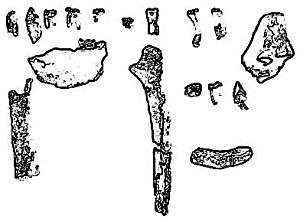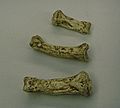Ardipithecus facts for kids
Quick facts for kids Ardipithecus |
|
|---|---|
 |
|
| Ardipithecus ramidus specimen, nicknamed Ardi | |
| Scientific classification |
|
| Unrecognized taxon (fix): | Ardipithecus |
| Species | |
Ardipithecus is a group of very old human-like creatures that lived millions of years ago. These creatures are called hominines, which means they are part of the group that includes humans and our closest extinct relatives. They lived during the Late Miocene and Early Pliocene periods in a place called the Afar Depression in Ethiopia.
Scientists first thought Ardipithecus was one of the earliest ancestors of humans. This was believed to be after humans and chimpanzees began to evolve separately. However, today, scientists are still discussing exactly how Ardipithecus fits into the human family tree.
There are two main species of Ardipithecus that scientists have found fossils for:
- A. ramidus: This species lived about 4.4 million years ago.
- A. kadabba: This one is even older, living around 5.6 million years ago.
Early studies suggested Ardipithecus might have behaved a lot like chimpanzees. But newer research, looking at their teeth, shows they were likely less aggressive. They might have been more like bonobos, which are known for being more peaceful.
Contents
Discovering Ardipithecus ramidus
The species A. ramidus was officially named in September 1994. The first fossils found were dated to 4.4 million years ago. This was figured out by looking at the layers of volcanic rock where the fossils were found.
The name Ardipithecus ramidus comes from the Afar language. Ardi means "ground" or "floor," and ramid means "root." The "pithecus" part comes from the Greek word for "ape."
What A. ramidus Looked Like
A. ramidus had a small brain, about 300 to 350 cubic centimeters. This is a bit smaller than a modern bonobo's brain. It is much smaller than the brain of later human relatives like Lucy (Australopithecus). It was also only about 20% the size of a modern human brain.
Like most early human relatives, A. ramidus had a big toe that could grasp things. This helped them move around in trees. Scientists are still studying how much of their skeleton was also good for walking on two legs on the ground.
One interesting feature was their canine teeth. These teeth were smaller than those of many other apes. Also, the canine teeth of males and females were very similar in size. This suggests that males might have been less aggressive with each other.
Where A. ramidus Fossils Were Found
In 1992 and 1993, a team led by Tim D. White found the first A. ramidus fossils. These included skull pieces, jawbones, teeth, and arm bones. They were found in the Afar Depression in Ethiopia. More pieces were found in 1994, making up about 45% of a full skeleton.
At first, this fossil was thought to be a type of Australopithecus. But later, White and his team decided it was a new group, which they named Ardipithecus.
Between 1999 and 2003, another team found bones and teeth from nine different A. ramidus individuals. These were found in the Gona area of Ethiopia. These fossils were dated to be between 4.35 and 4.45 million years old.
What A. ramidus Ate
The teeth of A. ramidus were not specialized like those of some other apes. This suggests they ate a variety of foods. They were likely omnivores, meaning they ate both plants and meat. They were also frugivores, meaning they ate a lot of fruit. Their diet probably did not rely heavily on tough plant materials like roots or very hard foods.
The similar size of canine teeth in males and females is important. In many apes, males have much larger, sharper canines for fighting. The smaller, similar-sized canines of A. ramidus suggest less fighting among males. This might mean they had more peaceful social groups. It also suggests they might have formed stronger pairs and cared for their young more.
Ardi: A Special Discovery
On October 1, 2009, scientists officially announced a very important discovery. They found a nearly complete skeleton of an A. ramidus female. This fossil was first found in 1994 and was nicknamed "Ardi."
Ardi was a small-brained female, weighing about 50 kilograms (110 pounds). Her skeleton included most of her skull, teeth, pelvis, hands, and feet. She was found in the Afar Region of Ethiopia.
Scientists used volcanic ash layers around the fossils to date Ardi. They believe she lived about 4.3 to 4.5 million years ago. However, some scientists have questioned this date. They suggest Ardi might be closer to 3.9 million years old.
Ardi's skeleton is very important because it shows us what human evolution was like. It helps us understand a time more than a million years before Lucy. Lucy was another famous early human ancestor who lived 3.2 million years ago.
How Ardi Moved Around
From her pelvis and limbs, scientists think Ardi could walk on two legs when she was on the ground. This is called bipedalism. But she could also move on all fours in trees. This means she was a "facultative biped," able to switch between walking styles.
A. ramidus had a more basic way of walking than later human relatives. They probably could not walk or run for long distances.
Ardipithecus kadabba: An Older Relative
Ardipithecus kadabba is an older species, dated to about 5.6 million years ago. We know about it mostly from teeth and small pieces of bones.
Scientists first thought A. kadabba was a subspecies of A. ramidus. But in 2004, new teeth were found in Ethiopia. These teeth showed different features, proving that A. kadabba was its own distinct species.
The name kadabba comes from the Afar language. It means "basal family ancestor," which fits its role as an older relative.
How Ardipithecus Lived
Scientists have studied the bones and teeth of Ardipithecus to learn about its life. They found that Ardipithecus likely spent a lot of its time on the ground. It gathered much of its food there. It also spent some time in trees.
Its habitat was a mix of woodlands and grasslands, with lakes and swamps nearby. This means they lived in an environment with both open spaces and trees.
Studies of their teeth also suggest that Ardipithecus ate a varied diet. They ate foods from both trees and the ground. This is different from chimpanzees, who mostly eat from trees.
Some scientists believe that Ardipithecus might show the first signs of human-like social behavior. They had smaller canine teeth and less aggressive faces than many other apes. This could mean they were more social and cooperative. This idea suggests that important changes in how human ancestors behaved happened long before brains got bigger or stone tools were used.
Ardipithecus was about 30-52 kilograms (66-115 pounds) in weight. This size made them vulnerable to large predators, like big snakes.
Images for kids
See Also
 In Spanish: Ardipiteco para niños
In Spanish: Ardipiteco para niños
- Australopithecus
- Paranthropus
- List of human evolution fossils
- Sahelanthropus




